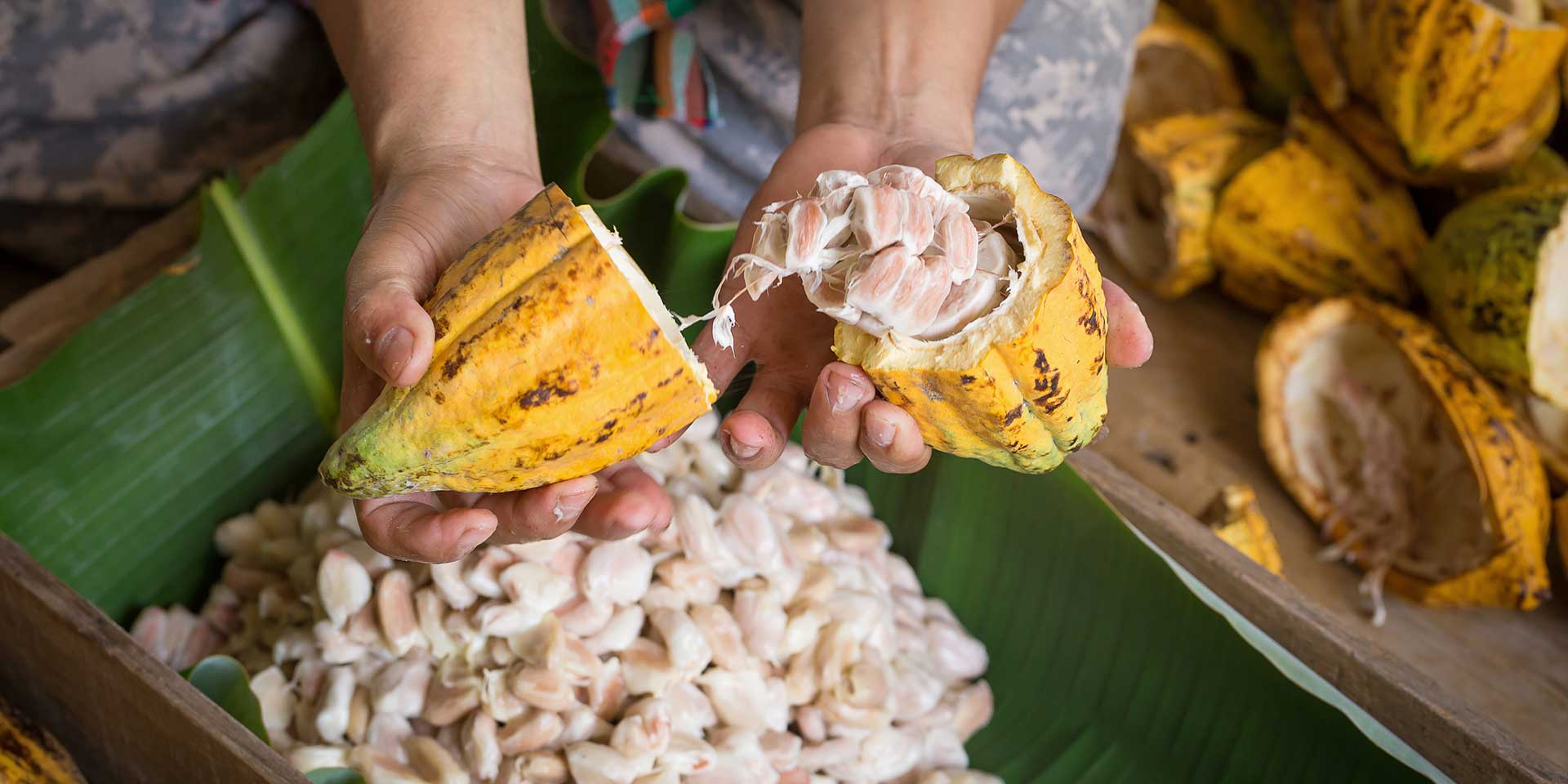For these cocoa farmers, sustainability and the price of beans are linked
“The shelves of our big box stores are stocked to the rafters with products, and we’ve come to take for granted their accessibility and low prices. What could be wrong with that?” writes food and agroecology writer Nancy Matsumoto in her new book, “Reaping What She Sows” (Melville House, October 2025). She has an answer, of course: a food ecosystem, shaped by massive, powerful multinational corporations, that is eroding “our health, our environment, [and] the health and wellbeing of our laborers.”
One cheap, popular product found in profusion on supermarket shelves is chocolate, the market for which was valued at $131 billion worldwide in 2024 — in spite of disease pressures, flooding and drought, all exacerbated by climate change, which have devastated production in the world’s top cocoa-producing region of West Africa. Chocolate is also an apt metaphor for so much of what Matsumoto identifies as problematic about our current global food system; it all too often relies on processes that extract value from watersheds, the land and the people who produce the things we eat, leaving a trail of compounding devastation in its wake. Chocolate giants such as Mondelez and Nestlé pay poverty wages for the commodity cocoa beans they buy. This can “lead to resource constraints and limited access to sustainable farming techniques and technologies, forcing farmers to resort to unsustainable land-management practices and excessive agrochemical use” that result in soil erosion, water pollution and loss of biodiversity, according to a 2023 study. One (not-at-all-simple) fix: “Reducing poverty [to] enable individuals and communities to adopt more sustainable practices and make responsible environmental choices.”
How to do just that has been the subject of decades’ worth of debate and many failed initiatives in the cocoa industry. Some smaller, ethics-minded chocolate companies have cropped up within the last two decades — think Tony’s Chocolonely, Alter Eco, Beyond Good — that promise better supports for farmers: through localized, bean-to-bar production; funding of community projects, professional development and schools; and buying at premium rates from farmer cooperatives that are certified organic, rainforest-friendly or slave-labor free. Improvements have been slow and small (and maddeningly, there’s evidence that paying more for cocoa is linked to higher rates of deforestation in countries like Cameroon). But Matsumoto, in one chapter of her book, considers the case of cocoa farmers in Belize, exploring how the chocolate industry could do much, much better by the workers who bolster it.
Maya Mountain, a cocoa exporter, was established in Belize in 2010. Back then, its founder and former community organizer, Emily Stone, told FoodPrint, “There were no supply chains set up that connected smallholder growers with what was, at the time, a very young bean-to-bar chocolate industry in the U.S.” That left chocolatiers like Taza struggling to find high-quality cocoa. At their behest, Stone traveled to Belize — where the annual production of cocoa in 2022 was 136 metric tons, versus 3 million from Ghana and Côte d’Ivoire. There, she talked to farmers to see what could be done to create “an alternative to the commodity market for trading cocoa beans that was focused on paying more for higher quality,” she says, while “helping grow supply for this burgeoning market.”
It took a while to convince Belizean cocoa farmers she was on the up-and-up — they’d been burned by chocolate companies before. But after several months of just listening, she was finally able to start buying direct from farmers at their homes, to make it as easy as possible for them to supply her with fresh, quality beans. The farmers continued to ferment and dry the beans themselves, although it soon became obvious to Stone that this was “really painful for them.” They first had to lug beans on their backs many hours from their farms in the mountains back down to their houses, where they then had to turn them for a week in “smelly” fermentation boxes outside their front doors or even inside their small thatched-roof residences before laying them out to dry. It was labor intensive, uncomfortable and left no time for any other tasks in their lives.
The clear solution: Buy the beans wet and centralize the fermentation, not only to ease the farmers’ burden but also to ensure there were no quality issues, like mold, that would make the beans less valuable or unsellable, thereby creating a better market structure for them. It took a decade to turn a profit, but Maya Mountain is now getting ready to transfer the company over to community ownership in Belize. And in the intervening years, Stone has begun sourcing from another 16 other countries under the company name Uncommon Cacao. Each country, Stone says, “has their own unique [bean] characteristics and existing market structure and pricing dynamics.” What makes it all work, she says, is that they are “literally buying wet cacao directly from the farmer, importing, warehousing and selling directly to the chocolate maker. It’s hard to get more efficient than that.”
The farmers, while by no means getting rich off their labor, are making between 41 and 162 percent more than commodity prices, Matsumoto reports in her book, and this is higher than the very small premium of about 9 percent that certifier Fairtrade International offers for organic cocoa beans from Belize, for example. Perhaps most significant of all is the fact that Uncommon Cacao publishes an annual report, based on yearly audits of all partners, that makes public the prices it pays its farmers for their beans.
“Our model we call ‘transparent trade,’ and the way we define that is verifiable, published pricing for every transaction related to a cacao purchase along the supply chain, including information about who produced it and where,” Stone says. It shows the premium paid to Uncommon Cacao farmers, versus the commodity “farm gate” price (literally, the price paid at the farm rather than elsewhere along the supply chain), versus what other entities are paying in any given region. “We’re still the only one to do it, but the reason we do it is to show that it’s possible to pay farmers more, to show that it’s possible to be transparent as a trader and thus make sure that you’re treating the value chain responsibly and held accountable to how you run your business as a trader.” Imagine, she says, if the Big Chocolate makers could be convinced to do the same: “That would uncover so much around where the inequities truly lie and where the challenges around sustainability come from.”
The Uncommon Cacao report also offers information on things like environmental practices and community-focused initiatives. But, Stone adds, “We’re not prescriptive in that you have to have a reforestation program running, or you have to have investments in school systems. It’s really a farmer-first, farmer-driven approach.”
As Matsumoto has witnessed firsthand in Belize, this all translates into “this really fanatic attention to detail to how the trees are planted and pruned and tended and harvested,” she told FoodPrint. The higher income that farmers are able to earn helps them “adhere to their farming protocols, which are regenerative and do help the land, rather than extracting from it and worsening climate change” — the latter a nightmare scenario that’s currently unfolding over much of the cocoa industry.
“It’s not just about making money. This is a really special crop, and all these different approaches to help people become more engaged with what cacao actually is are contributing to a better future for chocolate.”
Other companies have recently emerged that promise to put more money in cocoa producers’ hands, by figuring out how to create a market for products made from the usually discarded husks (which account for 50 percent of a harvested cocoa pod) and fruit (accounting for 25 percent of a pod); a clean-energy financier is backing a cocoa-husk–run bioelectricity plant in Côte d’Ivoire, while a Ghanian-Swiss company called Koa is turning fruit into juice and other products. Stone sees these as valiant efforts. “We’ve left a lot of money on the table, because we haven’t figured out how to become more respectful of the fruit,” she says. But “it’s not just about making money. This is a really special crop, and all these different approaches to help people become more engaged with what cacao actually is are contributing to a better future for chocolate.”
What’s left, says Matsumoto, is the need for critical buy-in from consumers, since Uncommon Cacao’s higher prices for beans absolutely translate into higher prices for boutique chocolate bars — especially now that the Trump administration’s tariffs have begun to tack on extra fees to imports of all kinds from pretty much all places. “If you feel like you want to make a difference as a consumer, don’t go to Mars or Mondelez, go to your bean-to-bar maker that you know is sourcing from Uncommon,” she says (there’s a list on their website). “Maybe you’re going to eat less chocolate. Maybe it’s going to be way more expensive. But at least you’re trying to direct your consumer dollars in a better, more ethical direction.”
Get the latest food news from FoodPrint.
By subscribing to communications from FoodPrint, you are agreeing to receive emails from us. We promise not to email you too often or sell your information.
Top photo by Uncommon Cacao.
More Reading
How Miyoko Schinner upped the game for vegan dairy
November 7, 2025
30+ things to do with a can of beans
November 4, 2025
In a beefy moment, beans?
November 4, 2025
Waste not, want not with “Ferment,” a new cookbook by Kenji Morimoto
October 1, 2025
You haven’t had wasabi until you’ve had it fresh — and local
September 11, 2025
How to make your kids’ school lunch more eco-friendly
August 19, 2025
No-cook meals: 40+ ways to enjoy peak summer produce without turning on your stove
August 12, 2025
Looking to jar up the season? Try a canning club
August 7, 2025
15+ ideas for delicious meatless grilling
July 1, 2025


